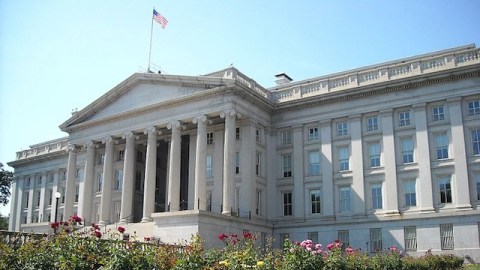The Debt Ceiling Explained

Congress created the debt ceiling crisis almost entirely on its own. Article I of the Constitution gives Congress what’s known as the “the power of the purse”: Congress alone can authorize spending, collect taxes, borrow money, or print money. The president can propose a budget, but it’s Congress that ultimately decides how much money the government spends.
So here’s the problem: Congress has told the president to spend more money than it has given him, but it hasn’t authorized him to borrow the extra money. Instead, Congress has set a limit on how much he can borrow—the debt ceiling—that is actually lower than the amount of money than he needs for the things it has already bought or told him to buy.
In 2011, the last time we approached a debt ceiling, Speaker of the House John Boehner (R-OH) accused President Obama of wanting “a blank check” to spend on government programs. But the truth is that President Obama is in a ridiculous legal bind. Under Article II of the Constitution, the president is legally required to spend money that he is forbidden to borrow. As many people have pointed out, Congress has essentially run up a large credit card bill that it refuses to pay.
Now Republicans in Congress want to extract concessions from the president in exchange for allowing him to borrow the money he needs to pay off the debts they helped create. If Republicans refuse to give the president more money, the country will have to default on financial obligations it already incurred. That would do huge damage to the country’s credit rating, drastically increase how much it costs the country to borrow money, and send financial markets into a panic. Republicans are effectively threatening to trigger financial crisis in order to push their particular budgetary agenda. Boehner himself has admitted that not raising the debt ceiling would mean “financial disaster, not only for us, but for the worldwide economy.”
As I wrote back in 2011, it’s not clear that Congress legally can impose a debt ceiling on the president. In essence Congress is requiring him to spend money and forbidding him to spend it at the same time. Some even argue that a clause in the 14th Amendment that says “the validity of the public debt… shall not be questioned”—a clause put in to prevent 19th-century Democrats from refusing to pay debts incurred during the Civil War—explicitly makes the debt ceiling unconstitutional.
President Obama has already ruled outtaking advantage of a legal loopholeto print more money. While only Congress has the constitutional authority to coin money, Congress has already authorized the president to mint commemorative platinum coins of any denomination. In theory, the president could mint a trillion dollar platinum coin and deposit it in the treasury. Since this strategy would clearly go against the intent of the commemorative coin law, it might not hold up in court. Printing money is also not a viable long-term strategy for paying a country’s bills because it devalues the currency although with interests historically low it might make sense right now. But, as Paul Krugman argued, minting a trillion dollar coin is not more ridiculous than requiring the president to obey two contradictory laws. And it would probably be better to be ridiculous and pay our bills than to be ridiculous and default on our debt.
The truth is that short-term solutions don’t address the fundamental problem. Both parties bear responsibility for our growing national debt. Deficit spending makes sense in moderation and in the short term, but over the long term Congress has to spend more within its means. That means both cutting spending and raising taxes, even though neither is politically popular. The debt ceiling simply makes the consequences of fiscal irresponsibility worse, by creating an artificial crisis and forcing the president to seek a second authorization for money Congress has already spent. Congress needs to eliminate the debt ceiling and start to get the budget right the first time.
Follow me on Twitter: @rdeneufville
Treasury Department image from AgnosticPreachersKid





